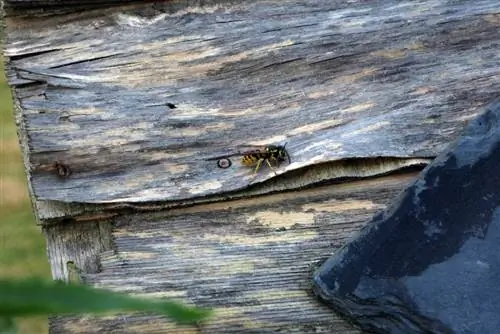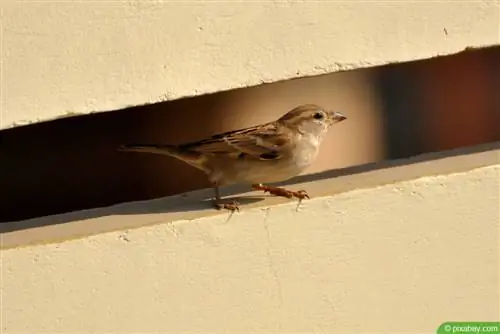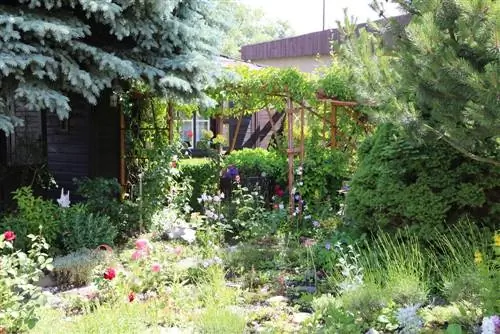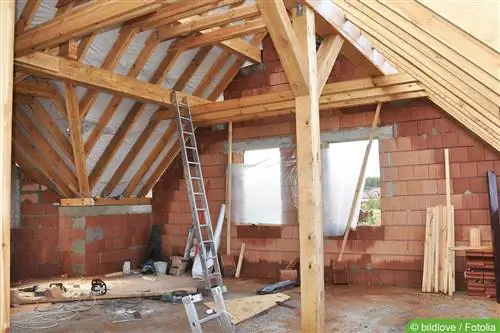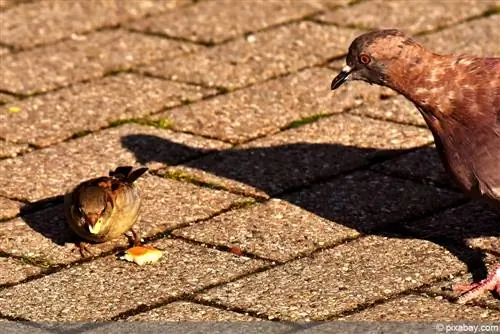- Author admin [email protected].
- Public 2023-12-17 03:39.
- Last modified 2025-06-01 06:48.
Wasps also like to build their own home on or in people's homes. Can this lead to serious damage to the house or subsequent damage to the structure? Is it possible for humans and wasps to coexist peacefully in this close proximity? If not, the question is how do you get rid of them? Or preventatively, what can you do to prevent them from nesting in the first place? Some basic knowledge about wasps, wasp nests, roofs and facades can help to act appropriately in individual cases.
Wasp species
Around 4,000 different species are assigned to the family of wasps (Vespidae). There are two subfamilies here, the solitary wasps and the true wasps.
The subfamily of real wasps is divided into three groups: hornets, long-headed wasps and short-headed wasps. The species of long-headed wasps are hardly a nuisance to us because they do not seek close proximity to humans. In addition, they are short-cyclical and disappeared from the scene from the end of August. They usually build free-hanging nests, in trees, bushes and occasionally under an eaves. But this construction method does not pose any problems for the building structure. As a rule, these are the following species:
- Middle Wasp
- Saxon wasp
- Wood wasp
- Norwegian wasp
The three species of wasps that we usually deal with are: the German wasp (short-headed wasp), the common wasp (short-headed wasp) and the hornet.
Lifestyle
Almost all real wasps form colonies, including the common wasp and the German wasp. They build nests and have a queen. Their penchant for treating themselves to lots of sweets towards the end of summer makes them annoying for humans.
Nest
These two species like to build their nests in secret and close to us. Popular nesting places are the compost heap, in the ground, under the roof or in facades or roller shutter boxes. Your states can consist of up to 7,000 individuals.
The material they use for this, the wasp paper, is made of wood. To do this, they mainly mix rotten or dry wood with their saliva, which creates small balls. These are then built into brood combs. The dried material is extremely hard and resilient.
Lifecycle

A wasp's life is very short. A young queen begins to found her state in the spring:
- Queen builds a few honeycombs
- lays eggs and feeds them until
- the first workers hatch
- Workers now take on further nest building and feeding additional larvae
- the larvae are fed exclusively with a porridge made from insects
- Queen is then almost solely responsible for laying eggs
- the nest is growing
- Drones (fertile males) hatch in late summer
- and young queens
- the drones die after mating
- the young queens fall into hibernation under rotten wood
- the old queen dies in October/November along with her entourage
Every year a young queen builds a new nest. Old buildings are no longer occupied. However, old nests that still exist can persuade the queen to settle nearby through their smell.
Damage - Benefit
Before we get to the (building) structure when it comes to wasp nests, a brief overview of what damage can be expected and whether these pests (mainly: short-headed wasps, hornets) can also be useful in some way. What happens when hornets, common and German wasps build their nests directly on, in or in the immediate vicinity of the house:
Damage
- Removal of material for access points
- Gnawing material for nest building
- Nest can block blinds
- aggressive behavior due to people being too close to the nest (<2 to 3 meters)
- Discoloration, caustic, smelling feces (in hornets)
Benefit
- eat pests, including aphids, tree pests and mosquitoes
- eat carrion, dead animals
- pollinate the local flowers
Roof tiles, attic
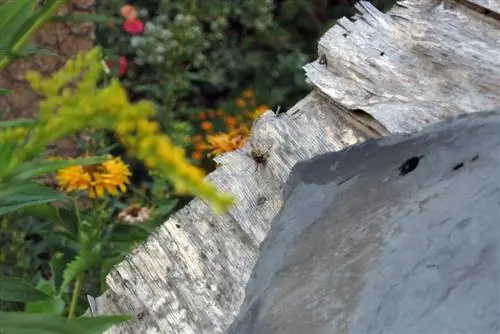
Especially older houses and houses that are under monument protection offer attractive opportunities for searching queens to build their nest right here. The roof tiles are not complete, they are mostly irregular because they are handcrafted and thus allow wasps entry and shelter. It's dark and protected here.
Even the insulation material, if it is accessible and perhaps already porous, cannot stop a young queen willing to build from gnawing her way through. After all, a dry, protected place under the roof, in the loft or attic is tempting.
If a roof truss made of dry, untreated or even rotten wood is added, this seems to be a paradise for building nests, after all, the building materials are included in the delivery.
These circumstances suggest that in most cases it is not the wasps themselves that cause the most damage. They are more likely to take advantage of favorable opportunities, or any existing weak point that comes their way, to build their nest.
Facade, insulation
Basically, the facade is the same as the roof. Every weak point is exploited by the young wasp queen in search of suitable building land. In most cases, the wasps only cause further damage. Exactly when previous damage or negligent construction allows this.
It seems to be an invitation if the facade allows free access to the insulation layer. With their biting tools, the wasps can easily gnaw their way through until a suitable cavity is found. Serious damage occurs when a so-called cold bridge is created by the damage caused by corrosion. The facade itself is not particularly at risk, as wasps do not nibble through plaster, concrete, stone or similar hard substances.
Dangerous areas in the facade are:
- Cracks in the external facade
- missing, damaged base rails, base profiles (edges)
- Inadequate connection from the concrete slab to the thermal insulation composite system (ETICS)
- insufficient reinforcing plaster (with mesh) at connection, masonry and finishing plaster
Roller shutter boxes
Here you can almost always find suitable access to dark, protected cavities that are perfect for a wasp nest. If the construction projects are not discovered early enough, sooner or later the functionality of these external blinds will suffer.
Distance
Mostly, wasp nests built in facades or in the roof are only discovered when the population of the wasp colony and thus the nest have increased significantly. Then it is usually already mid-August. Now comes the time when the wasps develop an appetite for sweets and become increasingly annoying. Beforehand you often don't even notice them.
Normal case
It's practically over for this season. It's important to somehow come to terms with the wasps for the last warm days outdoors. There will no longer be any additional damage to the building structure.
An uninhabited nest can then be easily removed in winter. It is important to then completely remove the nest and then thoroughly clean the surrounding area, for example with a water and vinegar mixture. Then this place offers no incentive for the young queen in spring to build her nest in this environment again. Of course, all structural loopholes should be repaired afterwards.
Tip:
It's even better to wait until early spring to remove the nest. Because in winter the nests are often used by useful insects, such as parasitic wasps, for overwintering.
Emergency
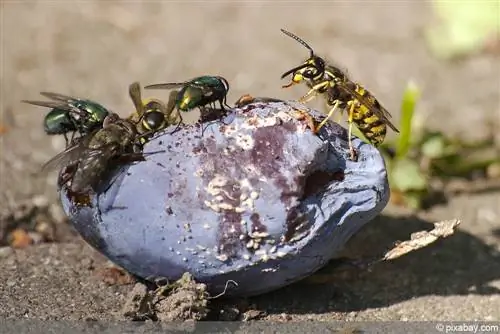
However, if you discover a nest and it becomes a threat to the family, you are faced with the question: How do we get rid of it as quickly as possible? Once again, if you discover a large, finished wasp nest, it will no longer be able to cause any further major damage to the house in the same year. The only question is: can we live with this until November or is this impossible? For example, due to:
- Allergies in the family
- they gained access to the interior from the roof
- Entry route to the nest runs across heavily used paths, entrances
In these cases, it is best to contact a responsible municipal advisory service. The local fire department can also either help or give appropriate advice.
Warning
There are various reasons why you should not remove wasp nests yourself. Here are the most important ones:
- you should never radically kill any living beings
- Over-the-counter insecticides against wasps are not potent enough for effective use
- Fumigation is a very dangerous idea, especially in older houses
- Blocking entrances (gluing, filling): very bad for nests on the house, new passages are bitten through, possibly even into an interior space
- all unsuccessful attempts to destroy a wasp nest makes the animals doubly aggressive
- The Federal Nature Conservation Act (BNatSchG) prohibits killing wild animals without a reasonable reason
In an emergency, it is always better to seek specialist advice. The responsibility can be found out through the fire department or the respective municipality.
Precautions, Prevention
The best measure to protect your home and residents from structural damage and punctures is prevention.
Wood
Wood is a material that wasps need to build their nests. Poorly maintained, rotten wood on the house is an invitation. There are now also environmentally friendly paints and varnishes that can be used to process wood so that they no longer provide an incentive for wasps. Good care of wooden cladding, roof trusses and wooden cladding should take place regularly, if only for the sake of the building structure.
Facades
Cracks and missing edges on facades should not be taken lightly. Regular inspections and, if necessary, repairs keep the house in good condition and also ensure that it remains unattractive for queens looking for a home.
Tip:
Attention, any free access to the insulation material between the facade and the wall is attractive for wasps looking for a new home.
Roller shutter boxes
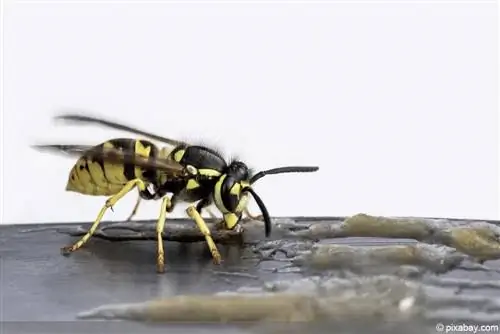
Here you can take preventative care to keep the openings as small as possible and check them more often in the spring. True to the motto, defend yourself from beginnings.
It's actually easy to observe. With a few squirts of lemon juice you can then prevent the queen from settling here. If it is already too late, do not try to get to the nest yourself or spray it with poison. In every community there are contacts who can help with problems with wasp nests.
Togetherness
If a wasp's nest does not pose a threat to the house and residents, then it is best to let them go. If you follow a few rules for peaceful coexistence, there will be no unpleasant incidents.
- don't get too close to the wasp nest
- are there wasps nearby, no hectic movements
- Don't blow on wasps
- Remove fallen fruit regularly
- Be careful when eating and drinking outdoors
- If necessary, install fly screens in front of the windows
Legal
There are two laws that protect wasps:
- According to Section 39 Paragraph 1 () of the Federal Nature Conservation Act (BNatSchG), it is forbidden to “kill wild animals without a reasonable reason”. This law is of course a matter of interpretation, but it also offers basic protection for the quite common and annoying short-headed wasps.
- According to Section 44 Paragraph 1 () of the Federal Nature Conservation Act, it is forbidden to “kill wild animals of specially protected species.” In addition, species protection applies according to the Federal Species Protection Ordinance (BArtSchV). The protected wasps include hornets and three species of long-headed wasps (scythe wasp, buttonhorn wasp and Saxon wasp). But the middle wasp is also considered worthy of protection, although it is not mentioned by name.
The law provides for fines of 50,000 euros and prison sentences of up to five years. These are also reasons enough to never attack a wasp's nest yourself. To make matters worse, not everyone can distinguish long-headed wasps from short-headed wasps. Even confusion with bee nests happens from time to time.
Tip:
Homeowners with a wasp nest are not legally responsible for any damage or nuisance that these (“their”) wasps cause to their neighbors.
Conclusion
It's the old game, people love nature as long as they think they have it under control. Especially as long as it doesn't harm him or his property. There is definitely the possibility of a peaceful coexistence with the wasps. If homeowners notice damage to the house that is supposedly caused by a wasp's nest, they have to be honest: who was there first? The crack in the facade or the wasp's nest?

